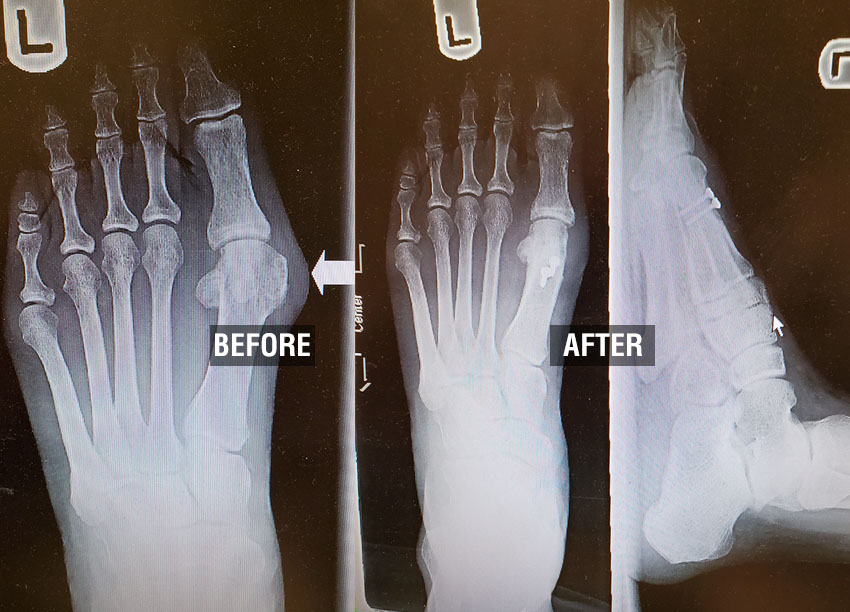Bunions
What is a Bunion?
A bunion (aka hallux abductovalgus in medical terminology) is a foot deformity in which a bony prominence develops at the base of the big toe. Contrary to popular belief it is not actually a growth of new bone. Instead it results from a shifting and malalignment of the first metatarsal bone just behind the great toe (aka hallux). As the metatarsal drifts medially it becomes more prominent on the side of the foot, creating the illusion that new bone is growing there. The big toe in turn drifts the opposite direction towards the smaller toes (aka abduction). The big toe may also rotate into a valgus position, hence the term hallux abductovalgus. A similar condition can occur at the base of the pinky toe called a bunionette or tailor’s bunion.

Causes of Bunions
- Inheritance is the most common factor in the development of bunions. Bunions tend to run in families. You can thank your parents or grandparents for your bunions if they too have them.
- Flat feet (aka pes planus) can increase your chances of developing bunions due to a complex biomechanical reason.
- Certain arthritic conditions such as rheumatoid arthritis can weaken the ligaments around the toes, making bunion and hammer toe deformities more likely.
- Interestingly, tight or narrow shoes do not necessarily cause bunions, but can certainly aggravate them and lead to pain.
Symptoms of Bunions
- A bump forming at the base of the big toe with outward deviation of the toe itself
- Redness and irritation from shoe pressure on the bump
- Pain is typically dull or throbbing in nature and worse in narrow or tight-fitting shoes
- Blisters or calluses may form on the bump over time
- You may notice the side of your shoe getting pushed or bulged out
- In long standing or severe bunions, the adjacent 2nd toe may get pushed out of the way causing a hammertoe. Painful corns may form between the toes from constant friction.
Non-Surgical Treatment of Bunions
The following measures can lessen the pain associated with bunions but will not permanently correct it:
- Wide Shoes which have adequate room in the toe box and a stretchy fabric material will result in less pressure and friction on the bunion.
- Pads such as tube foam or various silicone pads can help cushion the bump.
- Toe spacers can help separate the big toe from the adjacent smaller toes and may lessen pain in the joint itself
- Anti-inflammatories, both oral and topical may alleviate some discomfort
- Ice can help if the joint is acutely inflamed from overly tight shoes
- Steroid injections may provide some temporary relief
- Custom shoe inserts (aka orthotics) may lessen pain and there is some evidence they can slow or prevent the progression of bunion deformities

Surgical Correction of Bunions
If conservative treatments don’t relieve the pain, the deformity is significant and/or worsening, or it is limiting activities and/or shoe wear, then surgery may be needed. This is the only way to permanently correct a bunion. Most patients who undergo bunion surgery have a significant reduction in pain and deformity but even with surgery there is some chance of reoccurrence. It is often best to consider surgery earlier in the development of a bunion before it becomes really large and requires a more extensive procedure to correct it or before it causes a hammertoe deformity of the 2nd toe.
X-rays will be done to assess the severity of the bunion. We have computerized x-ray equipment available for your convenience at our office. A multitude of different procedures may be utilized to correct the bunion based on its size and complexity. This often entails an osteotomy (surgical cut) in the bone(s) to realign them followed by fixation with screws, staples, pins, or plates. The most common bunionectomy procedures we perform are Austin, Akin, or Lapidus surgeries. A period of immobilization after surgery with a special boot, cast or even crutches or a knee scooter may be needed. Full recovery can take 6-12 months in some cases. If you are having bunion pain please call us to schedule an appointment so we can help alleviate your discomfort.


Bunion Specialist
Judd Davis, DPM with A New Step Foot & Ankle Clinics is a compassionate podiatrist (foot and ankle doctor) who helps patients with surgical and non-surgical treatment of bunions and foot pain and other foot problems. A New Step Foot & Ankle Clinics is located in Colorado Springs, Colorado.


